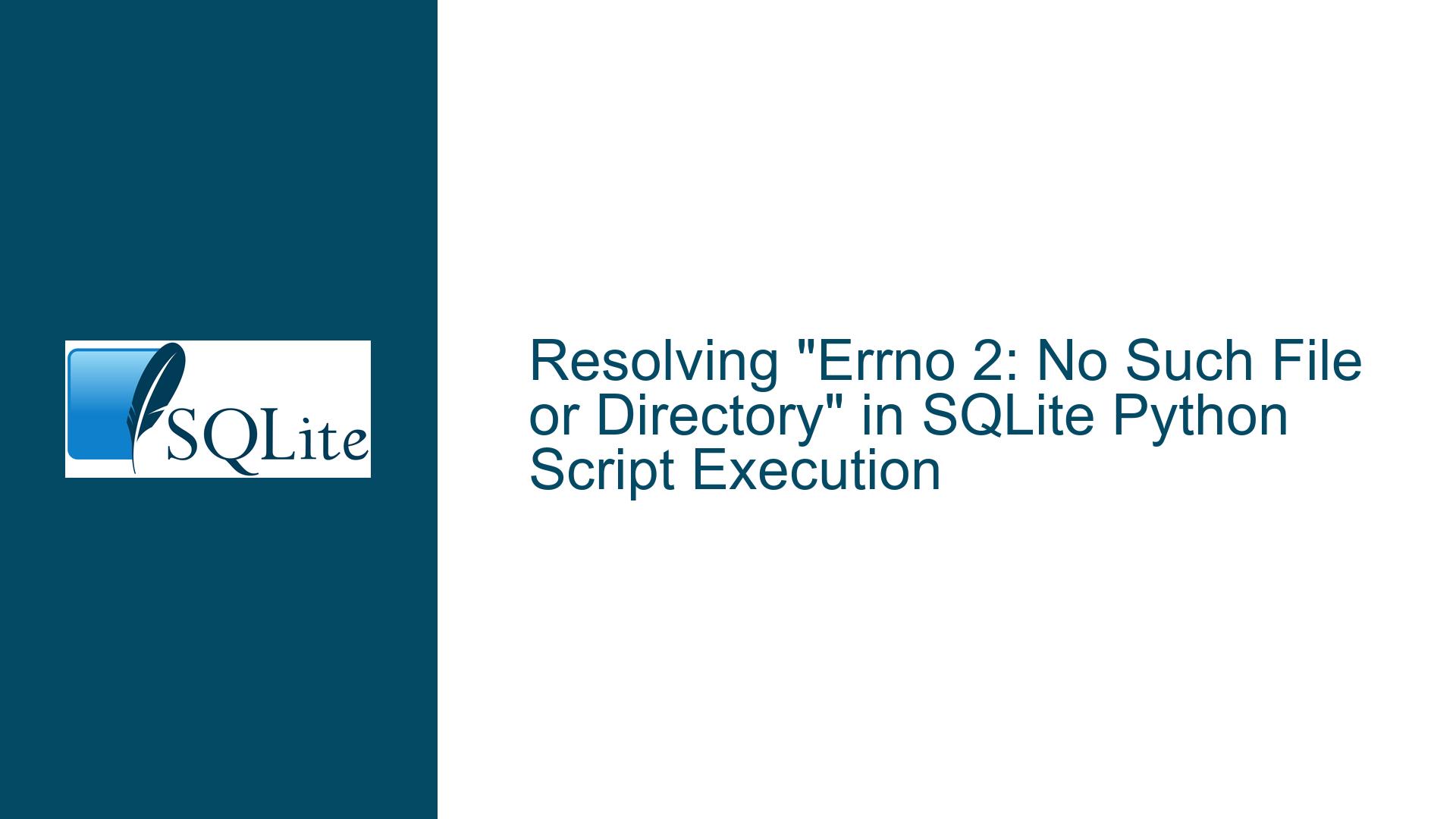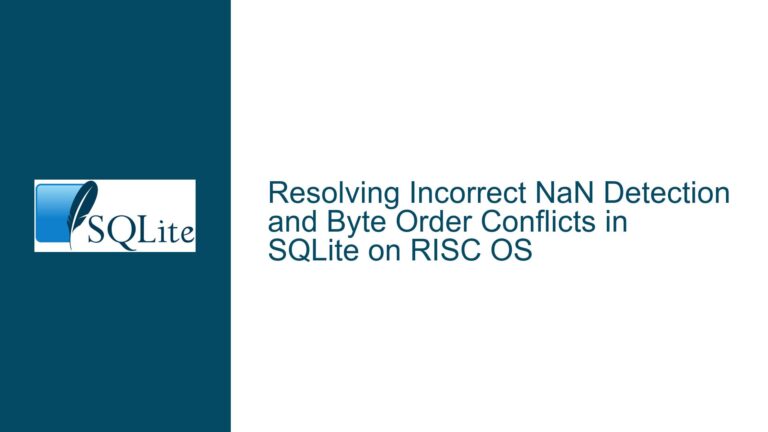Resolving “Errno 2: No Such File or Directory” in SQLite Python Script Execution
SQLite Python Script Execution Failure Due to Missing File
The core issue revolves around the execution of a Python script (database.py) that interacts with an SQLite database (address_book.db). The script fails to run, returning the error message: [Errno 2] No such file or directory. This error indicates that the Python interpreter cannot locate the specified file (database.py) in the directory from which the script is being executed. Despite the presence of the SQLite database file (address_book.db) in the root directory, the script itself is not found, leading to the execution failure.
The script in question is designed to create a SQLite database and a table within it using the sqlite3 module in Python. It also utilizes the tkinter library to create a simple GUI for a rental social media management system. The script is intended to be executed from the command line using Git Bash on a Windows system. However, the error suggests a misalignment between the expected and actual file paths, preventing the script from being located and executed.
Misconfigured File Paths and Environment Variables
The primary cause of the [Errno 2] No such file or directory error is the misconfiguration of file paths or environment variables. When executing a Python script from the command line, the interpreter relies on the current working directory to locate the script. If the script is not in the directory from which the command is executed, the interpreter will fail to find it, resulting in the error.
In this case, the user is attempting to run the script from Git Bash, but the script is not located in the current working directory (C:\Web_Dev). The error message indicates that the Python interpreter is looking for database.py in C:\Web_Dev, but the file is not present there. This discrepancy suggests that the user may have navigated to the wrong directory or that the script is located in a different directory altogether.
Another potential cause is the misconfiguration of environment variables, particularly the PATH variable. The PATH variable tells the operating system where to look for executable files. If the directory containing database.py is not included in the PATH, the system will not be able to locate the script, even if the user navigates to the correct directory manually.
Additionally, the script itself contains hardcoded paths, such as the path to the icon file (c:/Web_Dev/RSMM_Icon.ico). If these paths are incorrect or if the files are not located in the specified directories, the script may fail to execute properly, even if the primary issue of the missing script is resolved.
Correcting File Paths and Ensuring Proper Script Execution
To resolve the [Errno 2] No such file or directory error, the user must ensure that the script is located in the correct directory and that the environment is properly configured. The following steps outline the troubleshooting process:
Step 1: Verify the Current Working Directory
The first step is to verify the current working directory in Git Bash. The user can do this by running the pwd command, which will display the current directory. If the directory is not C:\Web_Dev, the user should navigate to the correct directory using the cd command. For example, if the script is located in C:\Web_Dev\scripts, the user should run:
cd /c/Web_Dev/scripts
Step 2: Check for the Presence of database.py
Once the correct directory is confirmed, the user should verify that database.py is present in that directory. This can be done using the ls command in Git Bash, which lists the contents of the current directory. If database.py is not listed, the user should move the script to the correct directory or navigate to the directory where the script is located.
Step 3: Update Environment Variables
If the script is located in a directory that is not included in the PATH environment variable, the user should update the PATH to include the directory containing database.py. This can be done by editing the PATH variable in the system settings or by adding the directory to the PATH temporarily in Git Bash using the following command:
export PATH=$PATH:/c/Web_Dev/scripts
Step 4: Validate Hardcoded Paths in the Script
The user should also validate the hardcoded paths in the script, such as the path to the icon file (c:/Web_Dev/RSMM_Icon.ico). If these paths are incorrect or if the files are not located in the specified directories, the script may fail to execute properly. The user should ensure that all referenced files are present in the correct locations and that the paths are correctly specified.
Step 5: Execute the Script
After ensuring that the script is located in the correct directory and that all paths are valid, the user can attempt to execute the script again using the following command:
python database.py
If the script executes successfully, the user should see the GUI window for the rental social media management system, and the SQLite database (address_book.db) should be created with the specified table (addresses).
Step 6: Implement Error Handling and Logging
To prevent similar issues in the future, the user should consider implementing error handling and logging in the script. This can help identify and diagnose issues more quickly. For example, the user can add a try-except block to catch and log errors:
import logging
logging.basicConfig(filename='database.log', level=logging.ERROR)
try:
# Existing code
except Exception as e:
logging.error(f"An error occurred: {e}")
Step 7: Automate Directory Navigation
To avoid issues with the current working directory, the user can automate the navigation to the correct directory within the script. This can be done using the os module in Python:
import os
# Change to the correct directory
os.chdir('/c/Web_Dev/scripts')
# Existing code
Step 8: Use Relative Paths
Instead of hardcoding absolute paths, the user should consider using relative paths. This makes the script more portable and less prone to errors caused by incorrect paths. For example, the icon file path can be specified relative to the script’s location:
import os
# Get the directory of the script
script_dir = os.path.dirname(os.path.abspath(__file__))
# Specify the icon file path relative to the script's location
icon_path = os.path.join(script_dir, 'RSMM_Icon.ico')
root.iconbitmap(icon_path)
Step 9: Test in Different Environments
Finally, the user should test the script in different environments to ensure that it works correctly across different systems and configurations. This includes testing on different operating systems, with different Python versions, and in different directory structures.
By following these steps, the user can resolve the [Errno 2] No such file or directory error and ensure that the script executes correctly. Additionally, implementing best practices such as error handling, logging, and the use of relative paths can help prevent similar issues in the future.
Conclusion
The [Errno 2] No such file or directory error is a common issue that arises when the Python interpreter cannot locate the specified script. This error is often caused by misconfigured file paths or environment variables. By verifying the current working directory, checking for the presence of the script, updating environment variables, validating hardcoded paths, and implementing best practices such as error handling and the use of relative paths, the user can resolve the error and ensure that the script executes correctly. Additionally, testing the script in different environments can help identify and address potential issues before they arise in production.






